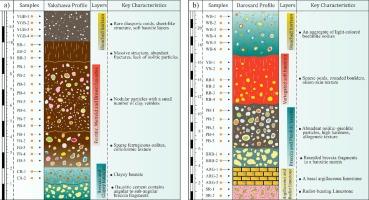The Middle-Late Permian Yakshawa and Late Cretaceous Daresard bauxite deposits, western Iran: Elemental deportment, parental affinities and genesis of REY minerals
IF 2.7
3区 地球科学
Q2 GEOSCIENCES, MULTIDISCIPLINARY
引用次数: 0
Abstract
The Middle-Late Permian Yakshawa bauxite deposit in the Sanandaj-Sirjan Zone and the Late Cretaceous Daresard bauxite deposit in the Zagros Fold-Thrust Belt have bauxite ores with different textures and mineralogical compositions. The presence of detrital and authigenic REY-phosphates, fluorocarbonates of the bastnasite group, and cerianite with diverse generations reflect an intricate formation process of the REY-bearing minerals in these two deposits. This clearly shows that the studied deposits have a multi-stage evolution including diagenetic and/or low-grade metamorphic, in situ fluid-assisted dissolution–reprecipitation reactions, and later bauxitization. The high abundance of monazite, textural relationships, and its LREE pattern indicate this mineral is the main LREE reservoir in the studied bauxite ores whereas xenotime, both authigenic and detrital, is the main host for HREE. The R-mode factor analyses indicates that the bauxitization process induces, at large, similar interelemental relationships in the studied deposits involving the attitude of Al oxyhydroxides, Ti oxides, and Fe oxyhydroxides to concentrate critical metals and the capability of REY-phosphate of being the main reservoir of REE + Y. As for provenance, the Eu/Eu*, Sm/Nd, and Nb/Ta proxies suggest that the bauxite ores of the Yakshawa deposit have a genetic relationship with Middle-Late Permian mafic volcanic rocks, whereas the ores of the Daresard deposit show parental affinity with the underlying fine-grained clayey limestone of the Sarvak Formation.

伊朗西部中-晚二叠世雅克沙瓦和晚白垩世达雷萨德铝土矿床:REY 矿物的元素分类、亲缘关系和成因
位于萨南达吉-锡尔詹地带的中-晚二叠世雅克沙瓦铝土矿床和位于扎格罗斯褶皱-推覆带的晚白垩世达雷萨德铝土矿床的铝土矿具有不同的质地和矿物成分。在这两个矿床中,存在不同世代的脱落和自生REY磷酸盐、姥钠石类氟碳酸盐和铈镧矿,反映了含REY矿物的复杂形成过程。这清楚地表明,所研究的矿床经历了多阶段演化,包括成岩和/或低级变质、原地流体辅助溶解-重沉淀反应以及后期铝土化。独居石的高丰度、纹理关系及其 LREE 模式表明,在所研究的铝土矿中,独居石是主要的 LREE 储层,而自生和非自生的氙则是 HREE 的主要矿床。R 模式因子分析表明,在所研究的矿床中,铝土矿化过程在很大程度上引起了类似的元素间关系,包括 Al 氧氢氧化物、Ti 氧化物和 Fe 氧氢氧化物浓缩关键金属的态度,以及 REY 磷酸盐作为 REE + Y 主要储层的能力。至于产地,Eu/Eu*、Sm/Nd 和 Nb/Ta 代用指标表明,Yakshawa 矿床的铝土矿石与中-晚二叠世岩浆火山岩有遗传关系,而 Daresard 矿床的矿石则与 Sarvak 地层下的细粒粘土灰岩有亲缘关系。
本文章由计算机程序翻译,如有差异,请以英文原文为准。
求助全文
约1分钟内获得全文
求助全文
来源期刊

Journal of Asian Earth Sciences
地学-地球科学综合
CiteScore
5.90
自引率
10.00%
发文量
324
审稿时长
71 days
期刊介绍:
Journal of Asian Earth Sciences has an open access mirror journal Journal of Asian Earth Sciences: X, sharing the same aims and scope, editorial team, submission system and rigorous peer review.
The Journal of Asian Earth Sciences is an international interdisciplinary journal devoted to all aspects of research related to the solid Earth Sciences of Asia. The Journal publishes high quality, peer-reviewed scientific papers on the regional geology, tectonics, geochemistry and geophysics of Asia. It will be devoted primarily to research papers but short communications relating to new developments of broad interest, reviews and book reviews will also be included. Papers must have international appeal and should present work of more than local significance.
The scope includes deep processes of the Asian continent and its adjacent oceans; seismology and earthquakes; orogeny, magmatism, metamorphism and volcanism; growth, deformation and destruction of the Asian crust; crust-mantle interaction; evolution of life (early life, biostratigraphy, biogeography and mass-extinction); fluids, fluxes and reservoirs of mineral and energy resources; surface processes (weathering, erosion, transport and deposition of sediments) and resulting geomorphology; and the response of the Earth to global climate change as viewed within the Asian continent and surrounding oceans.
 求助内容:
求助内容: 应助结果提醒方式:
应助结果提醒方式:


